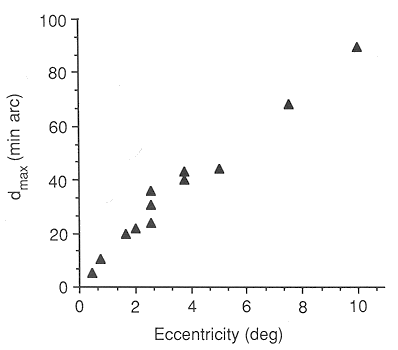How do we detect visual motion such as a moving object? Some may feel this is a very simple question for different reasons. ``I see it move from here to there.'' But this is part of the question, instead of the answer, because it implies that the visual signal received by the eyes is seen by, perhaps, a little person behind your eyes, presumably in your brain. This idea is called the ``Fallacy of the Homunculus'' (Latin for ``little man'') (Francis Crick). If this were the case, the question would become ``How does this little person detect motion?'' Obviously this kind of answer does not lead us to anywhere.
Another possible answer could be, ``The object is in one position at a moment
and in another position at next moment. So I know it is moving.'' It seems all
we need to do is to detect displacement and time. The motion can therefore be
derived as the velocity of the object:
The first experiment supporting the latter notion of the above was by Exner [3] (1888) who found that when an observer was presented with two sparks separated in space and time, motion could be perceived (a fact seemingly supporting the notion that motion is derived from displacement and time). However, Exner also found that when the spatial or temporal interval between the two sparks became smaller than some threshold values, the observer could no longer distinguish the two sparks (loss of sense of displacement or time) while he could still perceive motion. This result clearly supports the idea that motion is detected as an independent sensation in its own right, instead of being derived from other sensations. (Exner further suggested that there must be cells in the brain that were specialized for motion detection.) Exner's experiments and theory have been supported by overwhelming psychophysical and physiological data obtained in the last 100 years up to today.
The movie is the most popular and convincing evidence showing that vivid motion can be perceived when looking at a sequence of still image frames with certain objects gradually changing their positions. This kind of image sequence is called cinematogram.
An important parameter in this kind of motion illusion is dmax, a threshold value for the displacement, the distance between an object's positions in two consecutive frames. Only when the distance is smaller than dmax, will motion be perceived. The value of dmax is affected by certain factors such as eccentricity as shown below (Baker and Bradick 1985):

The value of dmax is also affected by the spatial frequency content of the stimuli. Suppose the displacement of a certain object is set to be slightly greater than dmax so that no motion is percived. Now if the image of the object is blurred, the perception of motion is restored. This result indicates that removing certain high frequency components contained in the pattern by low-pass filtering the threshold value dmax is increased.